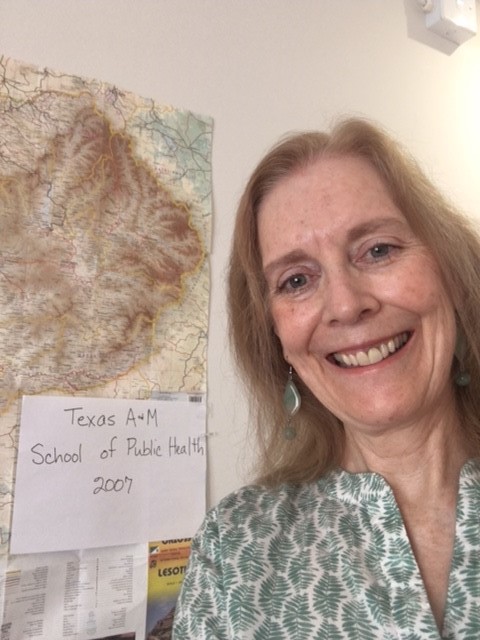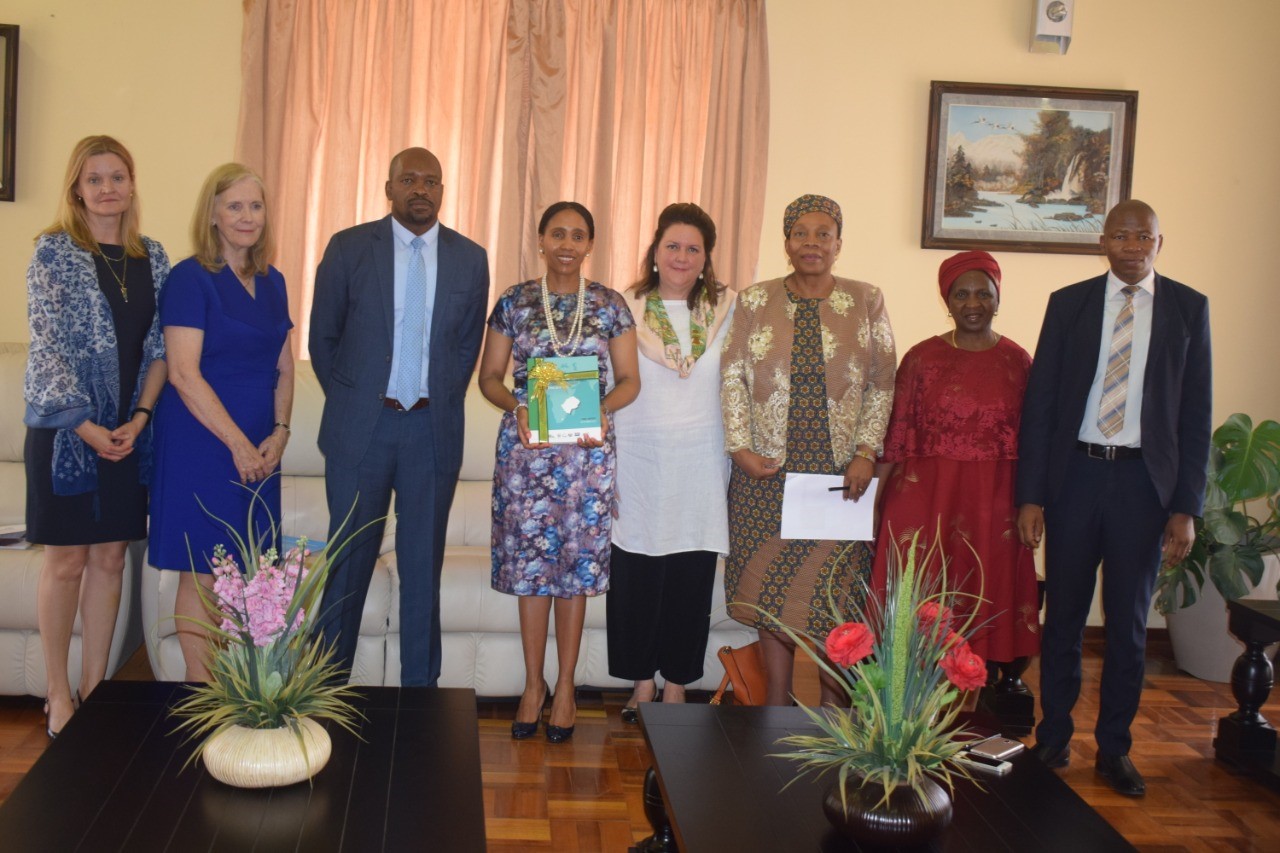Martha Conkling
SCHOOL OF PUBLIC HEALTH GRADUATE CONTINUES MANAGING HIV/AIDS EPIDEMIC
Martha Conkling, PhD, remains entrenched in her decades-long passion: tracking and preventing HIV transmission in Sub-Saharan Africa
The baby weighed just 7 pounds, about average for a healthy newborn. But at 14 months old, he should have weighed closer to 20 pounds. Born with human immunodeficiency virus (HIV) infection, he now showed one of the life threatening effects of the virus: severe weight loss or inability to gain weight. “For the rest of my life, I will remember weighing this one baby,” Martha Conkling, PhD, said.
This baby and many others like him were part of a study Conkling conducted in the early 1990s as a Fulbright Scholar in Zambia while working on her Master of Science in Public Health at the University of Utah. This experience  reinforced Conkling’s dedication to helping manage the HIV/AIDS epidemic. She concluded her field work in Zambia before moving back to Zimbabwe—her home from 1987 to 2001—to work as a project manager for the Adolescents and AIDS Prevention Project under the Department of Community Medicine at the University of Zimbabwe, and later as a biology teacher. From 2002 to 2007, she returned to the United States to pursue her PhD in Health Services Research at the Texas A&M University School of Public Health.
reinforced Conkling’s dedication to helping manage the HIV/AIDS epidemic. She concluded her field work in Zambia before moving back to Zimbabwe—her home from 1987 to 2001—to work as a project manager for the Adolescents and AIDS Prevention Project under the Department of Community Medicine at the University of Zimbabwe, and later as a biology teacher. From 2002 to 2007, she returned to the United States to pursue her PhD in Health Services Research at the Texas A&M University School of Public Health.
Witnessing the African HIV/AIDS epidemic
Well before these positions and degrees, Conkling began her career in southern Africa in the 1980s, learning about the field of public health in Zimbabwe. There, she assisted a retired public health professional from Canada in finding materials and navigating Zimbabwe to train community health workers. During this time, effective and widespread treatment for HIV did not exist, and Conkling watched as this epidemic devastated communities. “It was extremely, extremely obvious who had HIV,” she said. “People just became thin and sickly and they died.”
Martha Conkling, PhD, graduate of the Texas A&M School of Public Health, works with the Centers for Disease Control and Prevention in Lesotho tracking and preventing HIV transmission in Sub-Saharan Africa. Credit: Martha Conkling
Around the year 2004, the daily oral HIV treatment called antiretroviral therapy reached sub-Saharan Africa, but it was primarily available to immunocompromised individuals or the wealthy. More accessible and affordable medication revolutionized health in this region by keeping HIV infection from progressing into AIDS. Even so, HIV/AIDS remains the leading cause of death in sub-Saharan Africa.
That’s why, after 30 years of bouncing between sub-Saharan Africa and the United States, Conkling remains there. For the past two and a half years, she has worked in Lesotho with the Centers for Disease Control and Prevention (CDC). As the strategic information chief with the Lesotho-CDC office, she tracks the spread of HIV and how well people with HIV follow their treatment regimen. Conkling jokes that despite her job title, she oversees only one employee, as the CDC office in Lesotho consists of only 10 people.
Despite Conkling’s modesty, her responsibilities abound. She oversees the daily operations of her team and leads the CDC office science portfolio, meaning she must approve all articles, abstracts and grant proposals submitted. To better understand public health in Lesotho, her team also oversees the administration of public health surveys funded by the US government. Most recently, these have included the Population-based HIV Impact Assessment through Columbia University and the Violence Against Children and Youth Survey.
Achieving ‘epidemic control’
Lesotho has the second-highest prevalence of HIV in the world. Therefore the Lesotho-CDC team is funded through the U.S. President’s Emergency Plan for AIDS Relief (PEPFAR). Investing more than $85 billion globally, PEPFAR has saved millions of lives and helped control the HIV/AIDS epidemic in more than 50 countries, including Lesotho. “I wish the American people understood the real impact that this program has made in Africa and in the lives of people,” Conkling said. “We could really reach epidemic control this year.”
 The epidemic, Conkling explained, may be better understood in part by better tracking who has HIV and to whom they may transmit the virus—in other words, contact tracing, which has become familiar in the COVID-19 pandemic. The CDC-Lesotho team, however, is beginning to focus more on how well patients adhere to their antiretroviral therapy, or treatment retention. Conkling argues that, although treatment retention is important, difficulties in tracking treatment retention undermine the accuracy and utility of this data.
The epidemic, Conkling explained, may be better understood in part by better tracking who has HIV and to whom they may transmit the virus—in other words, contact tracing, which has become familiar in the COVID-19 pandemic. The CDC-Lesotho team, however, is beginning to focus more on how well patients adhere to their antiretroviral therapy, or treatment retention. Conkling argues that, although treatment retention is important, difficulties in tracking treatment retention undermine the accuracy and utility of this data.
Tearing down obstacles to long-term health
Lesotho, which is only slightly larger than Massachusetts, is surrounded by South Africa. Lax borders in some areas permit nonchalant—and illegal—travel between the countries. But the CDC-Lesotho team cannot access South African medical records. Thus, a resident of Lesotho can travel across the border for several months for work and possibly access their medication there, but as far as the Ministry of Health records are concerned, that patient has been forgoing HIV treatment. And even within Lesotho, the poor electronic infrastructure prevents the PEPFAR team from adequately tracking patient data between clinics. Through a new PEPFAR-supported electronic data system, however, “health information exchange is scaling up,” Conkling said.
Another obstacle in improving treatment retention is the gradual but sinister nature of HIV. Because HIV settles in before “tearing down the immune system,” Conkling said, many patients lack symptoms when they test positive during a routine check-up and so lack motivation to comply with daily treatment. But through contact tracing, the PEPFAR team can at least know who may be transmitting and acquiring HIV, which helps the CDC-Lesotho testing specialists to better target education and prevention efforts.
Conkling noted one unexpected disadvantage of accessible HIV treatment: younger populations have not seen the brutal effects of HIV and sometimes downplay its seriousness. HIV prevalence among people ages 15 to 49 is 24 percent in Lesotho, and Conkling said those who ignore the dangers of HIV can recklessly infect many people. Drawing parallels between HIV and the COVID-19 pandemic, Conkling said younger populations often consider themselves invincible.
Harnessing knowledge to make a real impact
Although she entered her PhD program with a wealth of knowledge and experience in international public health, Conkling said her skillset was expanded by her training at the Texas A&M School of Public Health. She explains that after receiving her PhD in 2007, she re-entered the workforce equipped with knowledge not only of public health, but also of scientific writing, survey database management, public policy and biostatistics. Conkling said she uses this knowledge daily, and she is thankful that her graduate education prepared her for meaningful work with the CDC. “Hopefully, I do the U.S. proud under PEPFAR,” she said. “It’s just been a really wonderful career.”